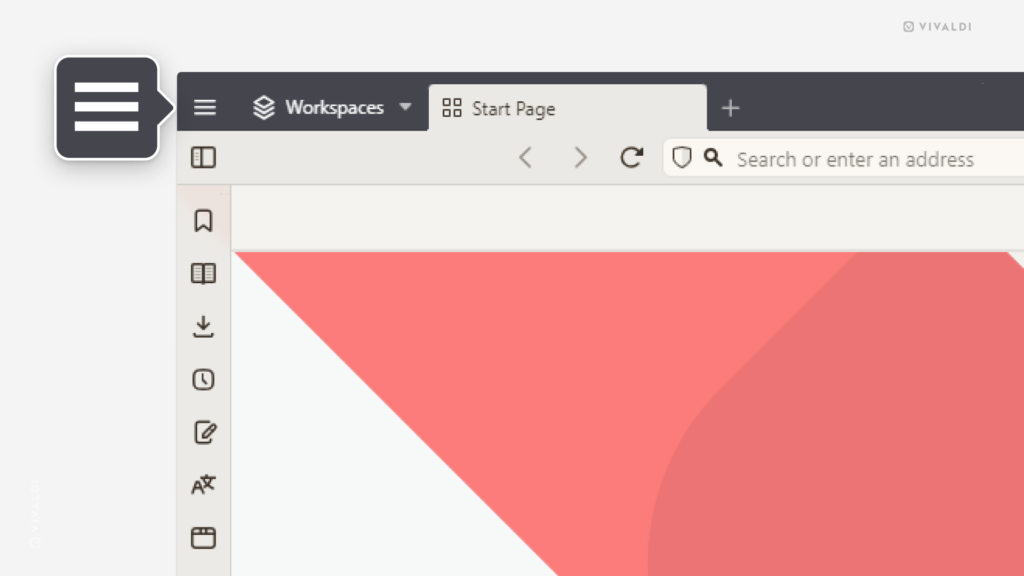Desktop Tips
Tip #502
June 6, 2024
Zoom Vivaldi Calendar view in and out with Keyboard Shortcuts.
In Tip #39 we told you about Keyboard Shortcuts you can use in the Vivaldi Calendar to switch to specific views (Day, Week, Month, etc.). In this tip, we’re introducing you to alternative shortcuts, which allow you to cycle through the views using the same two shortcuts.
To cycle through calendar views, press:
Alt + Page ↑– to zoom in, andAlt + Page ↓– to zoom out.
Step by step, you can zoom in from Agenda view down to Day view and from Day view out to Agenda view.
Tip #501
June 5, 2024
Create a new note with a screenshot from a web page.
Found something interesting on a webpage that you want to save, but an image would convey the message better than text? With Vivaldi, you can take a screenshot of the web page and automatically create a new note with it.
To save a screen capture as a note:
- Click on the
 “Capture page” button on the Status Bar.
“Capture page” button on the Status Bar. - Decide whether you want to capture a selection or the full page.
- Select “Create Note with…” as the output.
- If you chose to save just a section of the web page, select the area.
- Click “Capture”.
The captured screenshot will be attached to a new untitled note, which you can view and edit in the Notes Panel or Notes Manager.
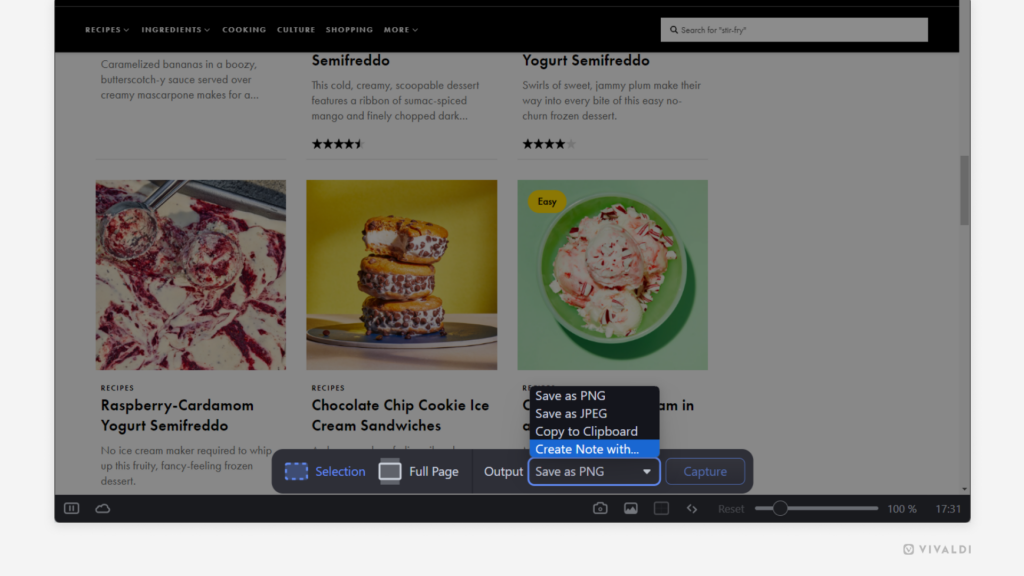
Tip #500
June 4, 2024
Zoom in and out on web pages using the number keys on your keyboard.
Single Key Shortcuts are a great way to get things done quickly and efficiently, without needing both hands or complicated finger gymnastics on the keyboard to reach multiple keys simultaneously. For example, you can use Single Key Shortcuts to zoom in and out on web pages.
To enable Single Key Shortcuts, go to Settings > Keyboard > Keyboard Shortcuts.
To zoom in and out, press the following numbers either above the letters on the keyboard or on the number pad:
- 0 – zoom in by 10%
- 9 – zoom out by 10%
- 8 – double the zoom level
- 7 – halve the zoom level
- 6 – reset the zoom level
Tip #498
May 31, 2024
Give your accounts in Vivaldi Mail display names.
Vivaldi Mail helps you organize and manage all your mail accounts from a single location in the Vivaldi browser. To make it easier to differentiate your accounts, you can give each account a display name.
To add a display name to an account:
- Go to Settings > Mail > Mail Accounts.
- Select an account.
- Enter a name in the “Account Display Name” field.
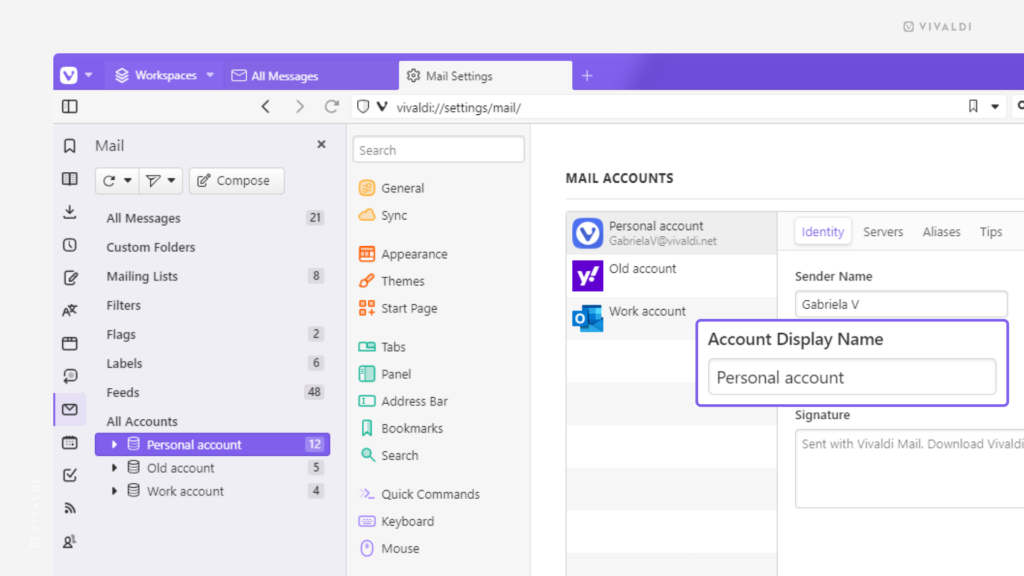
Tip #497
May 30, 2024
Merge multiple Tab Stacks into one by dragging one stack over the other.
Grouping tabs into Tab Stacks is an excellent way to keep your tabs well-organized. If you want to turn multiple stacks into one, you can do that using drag-and-drop on the Tab Bar or Windows Panel.
To merge Tab Stacks:
- Click on and start dragging one of the stacks towards the other.
- When the bottom tab stack changes color, release your mouse button to “drop” one stack onto the other.
If drag-and-drop doesn’t seem to work, go to Settings > Tabs > Tab Features > Tab Stack Options and make sure “Allow Stacking by Drag and Drop” is enabled.
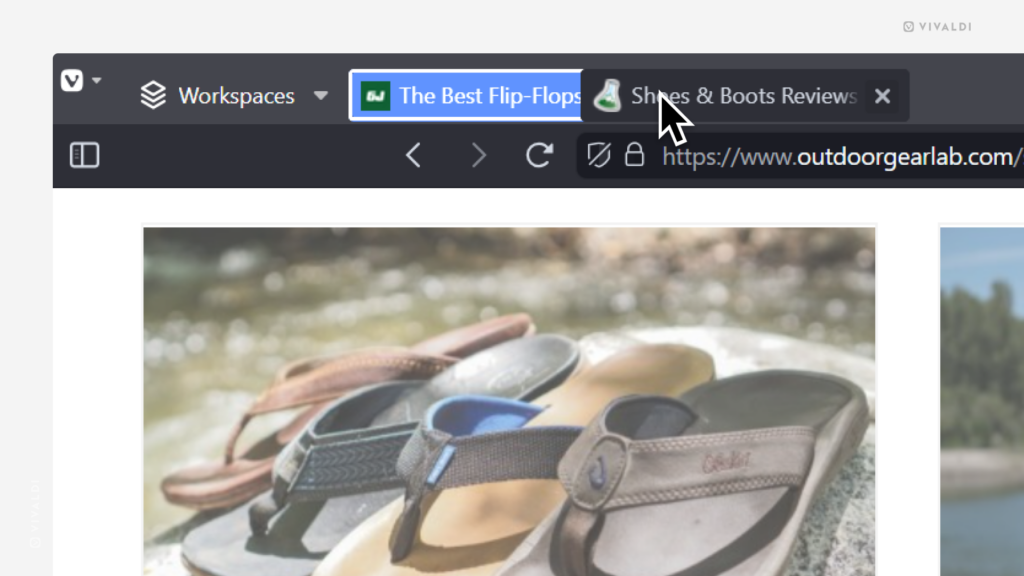
Tip #495
May 28, 2024
Tile Vivaldi with other apps for a split view from the browser window’s maximize button.
Many modern operating systems have made it easy to tile different apps and windows on the screen.
To tile Vivaldi with other apps on Windows:
- Hover over the maximize button in the top right corner.
- Select your preferred tiling option.
To tile Vivaldi with other apps on macOS:
- Hover over the maximize button in the top left corner.
- Select your preferred tiling option.
On Linux, tiling windows and apps depends on the distro’s window manager, but many allow snapping to a tiled grid by dragging the window or using keyboard shortcuts.
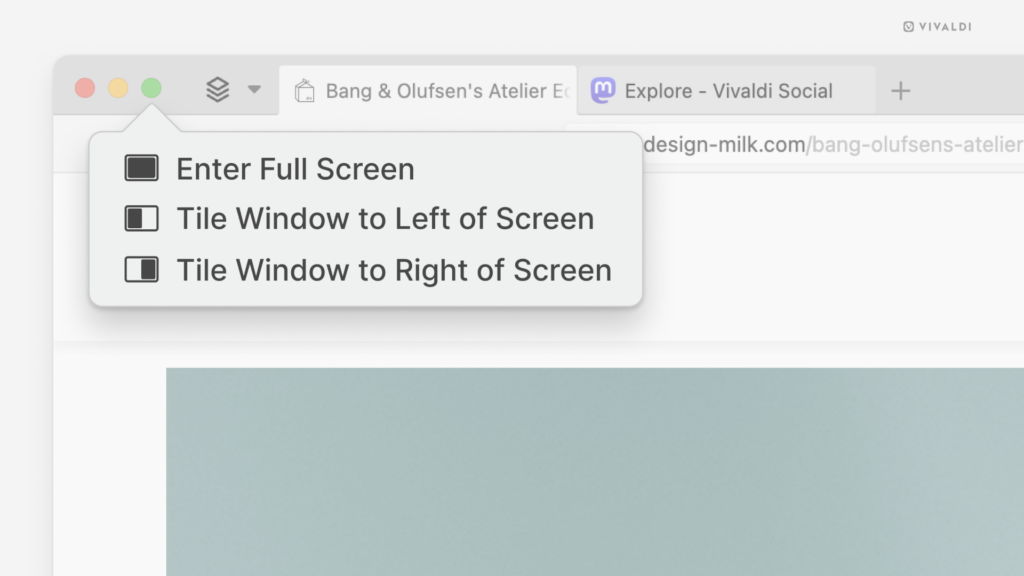
Tip #493
May 24, 2024
Sort Vivaldi Mail messages by the criteria that makes the most sense for you.
You can change the sorting order of Mail messages separately in each view, but it’s always good to have a fitting default setting.
To change the default sorting order:
- Go to Settings > Mail > Mail Settings > Mail List Sorting.
- Select your preferred option:
- Sort by Sender
- Sort by Subject
- Sort by Date Received
- Sort by Date (Threaded)
Tip #490
May 16, 2024
Use search filters in Vivaldi Mail to find the message you’re looking for.
Scrolling through your long lists of messages isn’t really an option if you receive a lot of mail. That’s when the search field with its filters comes to the rescue helping you find the message you’re looking for.
To search for a message in Vivaldi Mail:
- Type something relevant to the message in the search field.
- Use the available filters to narrow down your search.
The options include:
- Searching through all messages or specific accounts or folders.
- Specifying the date range.
- Looking for senders or recipients (From, To, CC).
- Searching by the email subject.
- Searching by something in the body of the message.
- Showing only messages that include attachments.
- Use the conjunction NOT to only find messages that do not match with the search keyword.
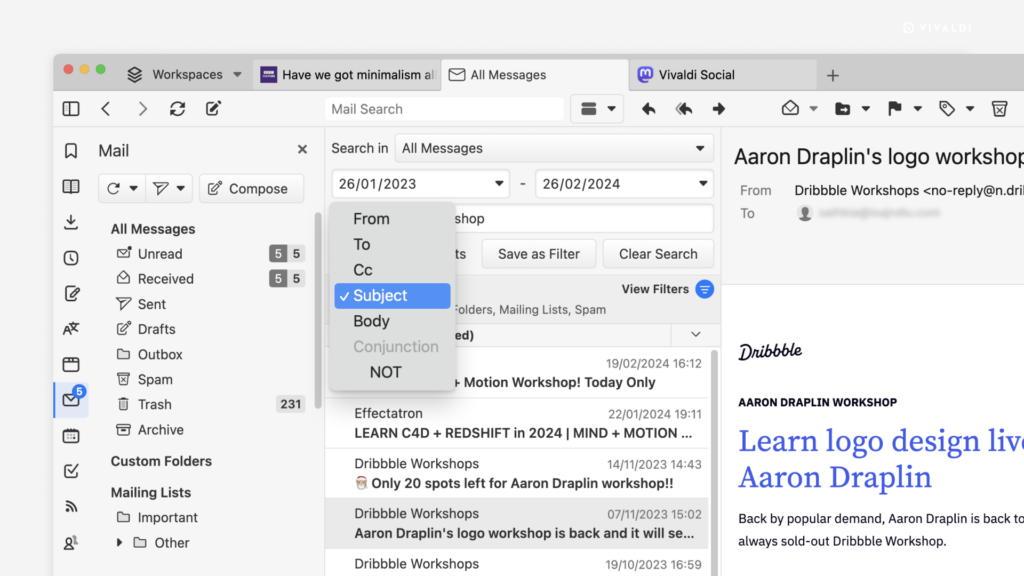
Tip #488
May 14, 2024
Create a new Workspace from a selection of tabs.
Have you cumulated a set of tabs that you would now like to move to a new workspace? Instead of first creating a new workspace and then moving the tabs, you can also create a new space while you moving tabs.
To create a new workspace from open tabs:
- Select the tabs you want to put in the workspace.
- Right-click on one of the selected tabs to open the context menu.
- Select Move # Tabs > Workspace > Create Workspace with Selected Tabs.
- Give the new workspace a name and select an icon for it.
- Click “Create”.
Tip #487
May 13, 2024
Import your feeds from other clients to Vivaldi Feed Reader.
Copying feeds you follow in other feed reader clients to Vivaldi is easy when the feeds can be exported as an OPML file. You can also move your subscribed feeds from one Vivaldi instance to another that way.
To import feeds:
- Export your feeds as an OPML file from your current client.
- In Vivaldi, go to the Vivaldi menu > File > Import from Applications or Files.
- From the dropdown menu, select “Feeds (OPML file)”.
- Click “Choose file” and locate your exported feeds file.
- Review the feeds’ titles and update frequency.
- Click “Add Feeds”.
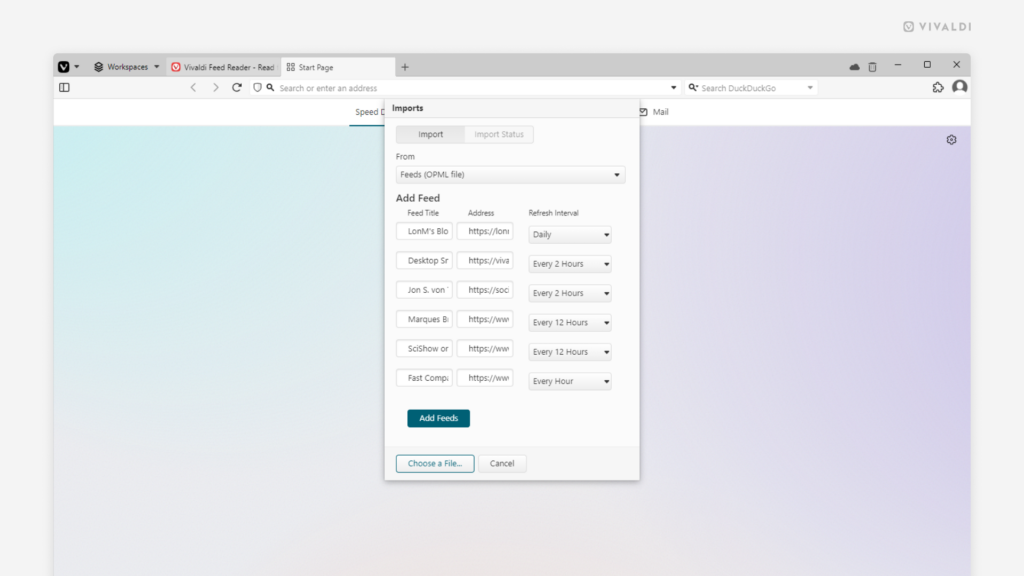
Tip #486
May 10, 2024
Boost Vivaldi’s performance by enabling the Memory Saver.
Reduce memory usage by automatically hibernating tabs that haven’t been used in a while. This way, active tabs, such as those used for gaming or streaming, can run more smoothly.
To enable the Memory Saver:
- Go to Settings > Tabs > Memory Saver.
- Select your preferred option:
- Disabled
- Automatic (recommended)
- After 1 Hour Idle
- After 2 Hours Idle
- After 3 Hours Idle
- After 6 Hours Idle
Tip #484
May 8, 2024
Tinker with Vivaldi’s appearance, all the way down to the menu icon.
On macOS, Vivaldi browser’s main menu is baked into the operating system, but on Windows and Linux you can access the main menu from the  icon in the top left corner of the browser window.
icon in the top left corner of the browser window.
If you wish, you can replace the  Vivaldi icon with a more generic, so-called “Hamburger”, ☰ menu icon. To do that:
Vivaldi icon with a more generic, so-called “Hamburger”, ☰ menu icon. To do that:
- Go to Settings > Appearance > Menu > Menu Icon Style.
- Select “Menu Icon”.
